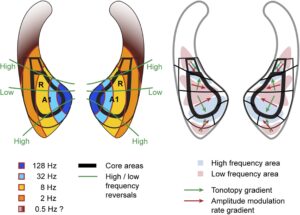Hearing the sound: In order to appreciate music, you first have to hear a sound, put together a string of sounds, and determine that they are different. Key brain regions involved in determining sound include the brainstem, thalamus, and auditory cortex. Your brain has several tonotopic maps, including in the auditory cortex, which is a frequency map, where low frequencies correspond to one side of the region and high pitches resonate on the opposite side (see picture).

These tonotopic maps allow us to determine different notes in a song even if we are not consciously aware of what the notes are. This is very important for speech and translates very well to understanding music. Furthermore, your brain processes sound differently than other senses. Sound itself is evanescent, or disappears instantly. To understand speech, your brain must temporarily remember what was said. This translates very well to understanding music, where briefly retaining what a song is doing helps you better appreciate its changes.
Predicting what comes next: We love finding patterns. It has been essential for our survival as a species and is important communication. Songs tap into these innate human instincts perfectly. Music itself is organized and has patterns. Even if you are not musically inclined, you can tell if notes are out of place, such as the wrong key or rhythm. This is because music builds upon what we expect in speech, happier sounds tend to be a part of happier music. We have subconsciously grown accustomed to hearing certain notes together. In fact many popular songs have a similar spacing between pitches and can actually be played with the same 4 chords, see the four chord song which combines many popular songs. Many pop songs can even be likened to lullabies we listened to as a child. This element of predictability is what makes songs interesting to us. Interestingly enough, songs appear to have a similar effect on the brain regardless if you like the song, meaning that the feeling of a song is very similar across people. Though to be most interesting to us, the song has to have a degree of unpredictability which will be discussed in the next session.
There are many behaviors that are essential for human survival, and as such, we have evolved to develop brain circuits that drive these behaviors for us. One classic example is that eating feels rewarding to us.. When presented with ‘rewarding’ stimuli, the brain responds by releasing the neurotransmitter, dopamine. The nucleus accumbens is a major brain region associated with motivation and award and is a target of increased dopamine. Keeping this in mind, a recent study determined that the nucleus accumbens was activated during peak ‘intense’ moments in a song such as an increase in dynamics or a change in tempo. Other studies have shown that removing these dynamic shifts and other musical components actually significantly reduces the enjoyability and recognition of a song. Furthermore, as you continue to listen to the same song, your brain will increase dopamine in anticipation of key transitions in the song. Over time your brain may get used to a song and no longer release as much dopamine.
It might not be known exactly why we love music. But it can be stated that it has a large connection to our need to communicate, desire to predict what comes next, and the dopamine released while listening.
Peer Edited by: Caitlyn Molloy